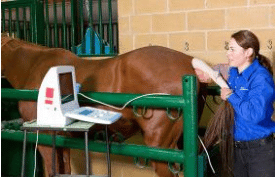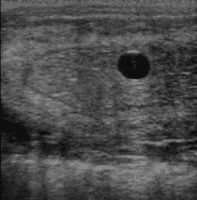 At Canberra Equine Hospital, we offer extensive reproductive services, including artificial insemination (AI) with either fresh, chilled or frozen semen. You also have the option of embryo transfer if you’d like the flexibility of having another mare carry the foal.
At Canberra Equine Hospital, we offer extensive reproductive services, including artificial insemination (AI) with either fresh, chilled or frozen semen. You also have the option of embryo transfer if you’d like the flexibility of having another mare carry the foal.
Does my mare need to come to the hospital?
So our vets can perform reproductive ultrasounds (scans) at accurate times, and to reduce the need for multiple transportations, we recommend mares stay at the hospital for around three to seven days, depending on her reproductive cycle. Alternatively, you can bring your mare to the hospital for each scan, and leave her with us just before she is due for artificial insemination.
How can we make her ‘come into season’?
Your mare is in season, or oestrus, when she’s receptive to the stallion in the lead up to ovulation. Oestrous behaviour can include urination and flagging to other horses, including geldings and other mares. Some owners can tell when their mare is in oestrus, and can therefore arrange her first scan when she starts this behaviour. If it’s difficult to tell when your mare is in season, you may be advised to manipulate her cycle using medication. Hormones called altrenogest and prostaglandin (PG) can be used to manipulate the mare’s reproductive cycle. Once she comes into season, her cycle will progress over a few days.
When does my mare have her scans?
To allow the vets to establish the optimum time for insemination, you should anticipate a minimum of six scans per cycle. Your mare should have her first scan when she first shows signs of being in oestrus (‘in season’), or on the fourth day after her PG injection. It is advised the PG injection is given on a Thursday, so your mare can have her first scan on a Monday.
So we can check that your mare has ovulated and has no fluid accumulation in her uterus, she will be scanned again the day after insemination. If she fails to develop a dominant follicle, she may require further scans, or the breeding attempt may have to be delayed until there is normal follicle development.
When will my mare be inseminated?
Insemination will happen as close to ovulation as possible. Scanning occurs around the clock, and may be during the night or on a weekend. An ovulation-stimulant is routinely used pre-insemination, to influence the developing follicle to ovulate.
When chilled semen is used, insemination is close to but before anticipated ovulation. For frozen AI, your mare will be scanned at approximately six hour intervals during the lead up to ovulation, before being inseminated as ovulation occurs.
See our Embryo Transfer information sheet to learn how this procedure works post insemination.
When do I need to order the semen?
As the mare owner, it’s your responsibility to communicate with the stallion’s agents/owners/stud to establish semen availability and the timeframe required for ordering semen prior to commencement of your mare’s cycle. You will also need to research transport options for the chilled semen to arrive in time. In most cases we are able to collect semen from Canberra Airport or another courier depot.
If we are preparing your mare for artificial insemination with PG, you should notify the stallion owner/agent the timing of doses so they can estimate when collection will be required.
Chilled semen should arrive within 24-48 hours of when the mare is anticipated to ovulate. Your treating vet will communicate closely with you or the stud to ensure the semen is ordered at the right time. Frozen semen should be delivered to CEH before your mare is brought into season or had her first scan.

How do I know if my mare is in foal?
Your mare will have her first pregnancy scan 16-18 days after ovulation (usually the day after the artificial insemination). This scan is crucial to detect if your mare has conceived twins, as twins can be impossible to detect or resolve later in the pregnancy. If twins have been conceived, one must be aborted to prevent severe complications during gestation. A second scan is ideal at 29 days, as many early pregnancies are lost around this time. The mare can return to cycle quicker than if we wait until the 45 day scan. To ensure your mare has retained her pregnancy during the early stages and assuming there are no complications, the final pregnancy scan should be done at 45 days.
If your mare is not in foal at any point up to 45 days, we will discuss your options if you wish to try again.
Are there any complications with AI?
Occasionally, a mare may have a reaction to the semen which will result in fluid accumulation within the uterus. If left untreated, this can lead to infection which may prevent conception on this attempt or further attempts at pregnancy. This fluid reaction is treated with a uterine contraction drug, with or without flushing the uterus with sterile fluids, and/or intrauterine antibiotics. Although all mares can develop a reaction, it is more common in older mares (over 13 years), who have a reduced ability to clear the uterus post insemination.
What costs are involved with AI?
Depending on the number of scans required, medications given (including sedation), and any complications, the cost estimates for each attempted AI cycle at the hospital during the 2023-2024 season are:
Fresh/Chilled: $1000-1200 plus agistment
Frozen: $1730-2000 plus agistment
Agistment: $66-78 day for a private yard
Services and medications not included in the cycle estimate include:
- Treatment of fluid accumulation pre or post AI.
- Other complications post AI or during the cycle.
- After hours fees if required.
- Sedation if required for ultrasound or AI procedures.
- Semen collection fees.
- Transport of semen from the airport or courier depot.
 We are always happy to discuss our reproductive services in more detail. Our aim is not only to give your mare her best possible chance of pregnancy, but also to ensure that the process is stress-free and rewarding for you as a horse owner.
We are always happy to discuss our reproductive services in more detail. Our aim is not only to give your mare her best possible chance of pregnancy, but also to ensure that the process is stress-free and rewarding for you as a horse owner.
